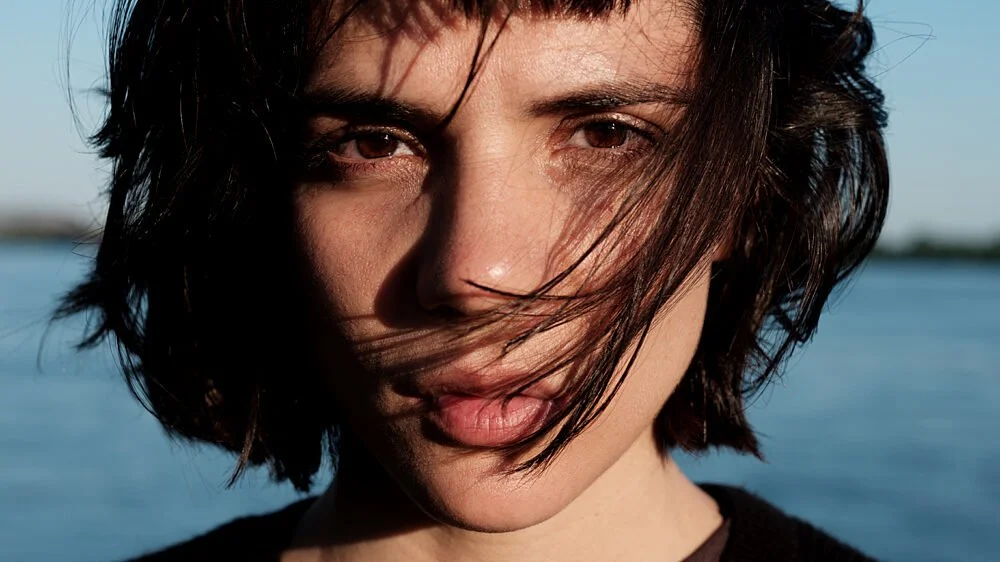In mind-bending trio Dog Rising, Clara Furey explores contactless shocks and hypnotic repetition
Plastic orchid factory presentation features an electro-immersive soundtrack and red-tinged lighting
Dog Rising. Photo by Mathieu Verreault
Plastic orchid factory presents Dog Rising at the Roundhouse Community Arts & Recreation Centre on January 12 at 7 pm
EDIFYING SHOCKS, bone-penetrating pulsations, and empathetic energy are just a few of the tangible qualities Clara Furey has injected into her hypnotic trio Dog Rising.
The Québécoise choreographer of Bent Hollow Compagnie began creating the piece in 2020, during the thick of the pandemic, so there’s no physical contact whatsoever between dancers Baco Lepage-Acosta, Be Heintzman Hope, and Brian Mendez.
Furey dove into a mind-bending exploration of how to make it appear as if a person had been touched without actually touching them. One dancer would let their movement flow from their body and ripple through space like an invisible wave until it reached the next body, creating a reactive hit. Persistence and repetition are key to this imagery, the choreographer says.
“One of the starting impulses of creating Dog Rising was about how to build the skeleton stronger—how to find a gestuelle, or a physical material, that we would be giving to the skeleton,” she tells Stir over a Zoom call. She’s speaking from up north of her home in Montreal, where she’s taking a winter vacation before making the trek to Vancouver for Dog Rising, which had a major showing at ImPulsTanz – Vienna International Dance Festival last summer.
Clara Furey. Photo by Guillaume Simoneau
Furey began her artistic journey not as a dancer, but as a musician. She studied formally in classical music at the historical Conservatoire National Supérieur de Musique et de Danse de Paris, and launched briefly into singing and songwriting as a young adult before training in dance at the École de danse contemporaine de Montréal. Furey’s work also spans into film acting.
Her pivot from music to dance came naturally as a person who is artistically inclined across disciplines.
“It was really a need regarding who I was mentally,” Furey shares. “I think piano playing is a very lonely thing, and I wanted to be more in groups. But also I needed to move very, very basically. And my love for dance definitely came from my love for music, you know? I’d be somebody that’d go out dancing to really good DJs. I think moving was a healthy way for me to canaliser my energy, like to hold my energy, and I felt I could continue my love for music through dance.”
In the vein of melding art forms, Furey’s commissioned solo When Even The pulled inspiration from Canadian singer-songwriter Leonard Cohen’s unfinished poetry. At a Musée d’art contemporain de Montréal exhibition devoted to the late icon, she performed the work 90 times from November 2017 to April 2018 next to Coaxial Planck Density—a lead sculpture of a dead body by British visual artist Marc Quinn.
“I don’t really draw a strong boundary between both mediums,” Furey says of dance and music. She also choreographed Rather a Ditch in 2019 for French-Canadian actress Céline Bonnier, an existential solo based on Steve Reich’s 1988 composition Different Trains.
Furey’s first piece as a solo artistic director was 2017’s Cosmic Love, a mindful investigation into vibrations, shared energy, and weightlessness. In a way, this exploration was the starting point for Dog Rising, adopting a more wide-ranging movement style.
“Definitely, at times, it can look mechanical,” Furey says. “Sometimes it looks more sexual depending on where in the body you’re getting the hit from. At times it can look like grooving you would do on a dance floor, but it’s so persistent that eventually it doesn’t look like someone on a dance floor. I could say it’s all of these rhythmical chest-openers and pelvis-givers.”
The physicality of Dog Rising is very much intertwined with the soundtrack, which hits close to home for Furey—it’s by her brother, Tomas Furey, with whom she frequently collaborates (he’s behind the music for Cosmic Love, too).
Trained in electro-acoustic instrumentations, Tomas weaves together layers of articulated beats in Dog Rising to create a percussive soundscape. Combined with predominantly red-tinged lighting, the music creates a mesmerizing experience for viewers. It’s as integral to the piece as the dance movement itself.
“Music always holds a really big part of all the work I do,” Furey says. “And in certain ways, I feel like sometimes the dance is also just about embodying this kind of electro-immersive sound, because it’s very much part of artistically what I adore.
“I’ve always so far worked with zero scenography, nothing in the space, and I feel like sound is the architecture of the room, you know? It really feels like sound takes so much space in this kind of work,” she continues. “You know that feeling with sound that you can feel in a big church, or in a dark cavern—how sound can create rooms? I feel like there’s a lot of space in this work, and the way I work, for sound to do that.”














